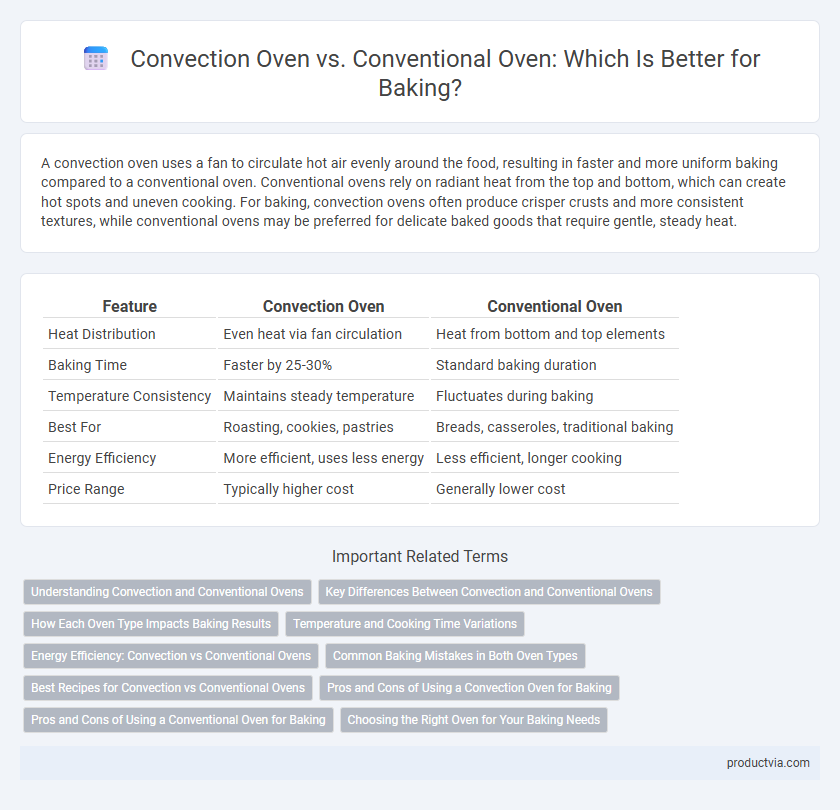A convection oven uses a fan to circulate hot air evenly around the food, resulting in faster and more uniform baking compared to a conventional oven. Conventional ovens rely on radiant heat from the top and bottom, which can create hot spots and uneven cooking. For baking, convection ovens often produce crisper crusts and more consistent textures, while conventional ovens may be preferred for delicate baked goods that require gentle, steady heat.
Table of Comparison
| Feature | Convection Oven | Conventional Oven |
|---|---|---|
| Heat Distribution | Even heat via fan circulation | Heat from bottom and top elements |
| Baking Time | Faster by 25-30% | Standard baking duration |
| Temperature Consistency | Maintains steady temperature | Fluctuates during baking |
| Best For | Roasting, cookies, pastries | Breads, casseroles, traditional baking |
| Energy Efficiency | More efficient, uses less energy | Less efficient, longer cooking |
| Price Range | Typically higher cost | Generally lower cost |
Understanding Convection and Conventional Ovens
Convection ovens use a fan and exhaust system to circulate hot air around food, promoting even cooking and reducing baking times. Conventional ovens rely on radiant heat from the top and bottom elements, which can create hot spots and uneven baking results. Understanding these differences helps bakers choose the best oven for consistent texture and browning in baked goods.
Key Differences Between Convection and Conventional Ovens
Convection ovens use a fan and exhaust system to circulate hot air, resulting in faster and more even baking compared to conventional ovens, which rely on radiant heat from the top and bottom. This airflow significantly reduces cooking time by up to 25% and produces crispier crusts, making convection ovens ideal for baked goods requiring uniform heat distribution. In contrast, conventional ovens excel at baking delicate items like custards and souffles where gentle, consistent heat without air movement is preferred.
How Each Oven Type Impacts Baking Results
Convection ovens use a fan to circulate hot air, promoting even heat distribution that results in faster and more uniform baking, ideal for crispy crusts and consistent browning. Conventional ovens rely on radiant heat from the top and bottom elements, which can create hot spots and uneven cooking but often provide a gentler, moist baking environment suitable for delicate desserts. Understanding the impact of airflow and heat distribution in each oven type helps bakers optimize texture, rise, and color in baked goods.
Temperature and Cooking Time Variations
Convection ovens use a fan to circulate hot air, resulting in more even heat distribution and generally allowing baking at temperatures 25degF lower than conventional ovens while reducing cooking time by 20-30%. Conventional ovens rely on radiant heat from the top and bottom elements, which can create hot spots and slower, less consistent baking results. The consistent airflow in convection ovens promotes faster cooking and browning, making them ideal for baking pastries and roasting, whereas conventional ovens may require longer preheating and extended baking durations.
Energy Efficiency: Convection vs Conventional Ovens
Convection ovens use a fan to circulate hot air, which reduces cooking time and lowers energy consumption compared to conventional ovens that rely on static heat. This improved airflow ensures even heat distribution, enabling food to cook faster at lower temperatures, ultimately leading to significant energy savings. Studies show convection ovens can use up to 20% less energy while baking, making them a more efficient choice for consistent cooking results.
Common Baking Mistakes in Both Oven Types
Common baking mistakes in convection ovens include improper temperature adjustments, as convection ovens typically require reducing the temperature by 25degF to prevent over-browning or drying out baked goods. Conventional ovens often suffer from uneven heat distribution, leading to inconsistent baking results and the need for frequent rotation of pans. Both oven types can cause issues if baking times are not closely monitored, resulting in undercooked interiors or burnt exteriors.
Best Recipes for Convection vs Conventional Ovens
Convection ovens, with their circulating hot air, excel at baking recipes requiring even browning and faster cooking times, such as cookies, roasted vegetables, and casseroles. Conventional ovens provide steady, radiant heat ideal for delicate baked goods like souffles, cakes, and bread that benefit from slower, even rising. Adjusting temperature and cook time is crucial when switching between convection and conventional ovens to achieve optimal results for each recipe.
Pros and Cons of Using a Convection Oven for Baking
Convection ovens use fans to circulate hot air, resulting in faster and more even cooking, which reduces baking time and ensures consistent browning on baked goods. They are ideal for roasting and baking multiple trays simultaneously but can cause delicate items like souffles or cakes to dry out or cook unevenly if not monitored carefully. Conventional ovens provide gentle, radiant heat, preserving moisture and texture, yet often require longer cooking times and may result in uneven baking.
Pros and Cons of Using a Conventional Oven for Baking
Conventional ovens provide consistent heat from either the top or bottom heating elements, making them ideal for recipes requiring slow, even cooking such as cakes and bread with a tender crumb. However, they often result in uneven heat distribution, leading to hot spots and longer baking times compared to convection ovens. The absence of a fan means moisture remains, which can be advantageous for retaining moisture in baked goods but may cause less crispy textures on items like pastries.
Choosing the Right Oven for Your Baking Needs
Convection ovens use a fan to circulate hot air evenly, resulting in faster and more consistent baking, ideal for cookies, pastries, and multiple trays. Conventional ovens rely on radiant heat from top and bottom elements, offering a classic baking environment preferred for delicate recipes like souffles and custards. Selecting the right oven depends on your baking style: choose convection for speed and uniformity, or conventional for gentle, traditional cooking.
Convection oven vs Conventional oven for baking Infographic

 productvia.com
productvia.com